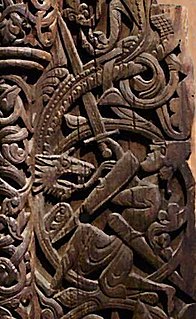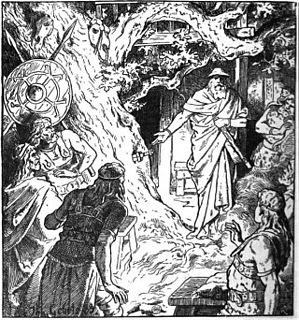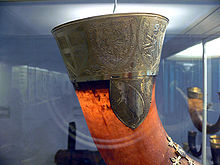
The Völsunga saga is a legendary saga, a late 13th-century poetic rendition in Old Norse of the origin and decline of the Völsung clan. It is one of the most famous legendary sagas, and an example of a "heroic saga" that deals with Germanic heroic legend.

In Norse mythology, Reginn is a son of Hreiðmarr and the foster father of Sigurd. His brothers are Fafnir and Ótr.
In Norse mythology, Hreiðmarr is a sorcerer. He is featured in the Völsunga saga and in Snorri Sturluson's Prose Edda.

In Norse mythology, Fáfnir is a son of Hreidmar and brother of Regin, Ótr, Lyngheiðr, and Lofnheiðr. After being affected by the curse of Andvari's ring and gold, Fáfnir became a dragon and was slain by Sigurd.

In Norse mythology, Sigmund is a hero whose story is told in the Völsunga saga. He and his sister, Signý, are the children of Völsung and his wife Hljod. Sigmund is best known as the father of Sigurð the dragon-slayer, though Sigurð's tale has almost no connections to the Völsung cycle except that he was a dragonslayer.
In Norse mythology, Völsung was the son of Rerir and the eponymous ancestor of the ill-fated Völsung clan, which includes the well known Norse hero Sigurð. He was murdered by the Geatish king Siggeir and later avenged by one of his sons, Sigmund, and his daughter Signy, who was married to Siggeir.
In Norse mythology, Grimhild or Grímhildr was a beautiful but evil sorceress who was married to king Gjúki of Burgundy in the Völsunga saga where she is the mother of three sons, Gunnar, Hǫgni and Guthormr, and a daughter, Gudrun. Other, similar characters of that name also appear in Illuga saga Gríðarfóstr and in Gríms saga loðinkinna.

In Norse mythology, Gram, also known as Balmung or Nothung, is the sword that Sigurd used to kill the dragon Fafnir. It is primarily used by the Völsungs in the Volsunga Saga. However, it is also seen in other legends, such as the Thidrekssaga in which it is wielded by Hildebrand.
In Völsunga saga, Rerir, the son of Sigi, succeeds his murdered father and avenges his death. He rules in Hunaland and becomes a powerful ruler. Rerir's son is Völsung.

"Völsungakviða" or "Helgakviða Hundingsbana I" is an Old Norse poem found in the Poetic Edda. It constitutes one of the Helgi lays, together with Helgakviða Hundingsbana II and Helgakviða Hjörvarðssonar.

Signy or Signe is the name of two heroines in two connected legends from Norse mythology which were very popular in medieval Scandinavia. Both appear in the Völsunga saga, which was adapted into other works such as Wagner's 'Ring' cycle, including its famous opera Die Walküre. Signy is also the name of two characters in several other sagas.

Sinfjötli or Fitela in Norse mythology was born out of the incestuous relationship between Sigmund and his sister Signy. He had the half-brothers Sigurd, Helgi Hundingsbane and Hamund.
Hámundr is a minor character in Norse mythology.

Dragons are present in Germanic mythology and folklore, where they are often portrayed as large venomous serpents. Especially in later tales, however, they share many common features with other dragons in European mythology.
In the Völsung cycle, Sigi is the ancestor of the Völsung lineage. In the Völsunga saga, he is said to be one of the sons of Odin. He is also listed among Odin's sons in the Nafnaþulur. He has a son called Rerir.

In Norse mythology, Barnstokkr is a tree that stands in the center of King Völsung's hall. Barnstokkr is attested in chapters 2 and 3 of the Völsunga saga, written in the 13th century from earlier tradition, partially based on events from the 5th century and the 6th century, where, during a banquet, a one-eyed, very tall man appears and thrusts a sword into the tree which only Sigmund is able to pull free. Scholarly theories have been put forth about the implications of Barnstokkr and its relation to other trees in Germanic paganism.

Sigurd or Siegfried is a legendary hero of Germanic heroic legend, who killed a dragon and was later murdered. It is possible he was inspired by one or more figures from the Frankish Merovingian dynasty, with Sigebert I being the most popular contender. Older scholarship sometimes connected him with Arminius, victor of the Battle of the Teutoburg Forest. He may also have a purely mythological origin. Sigurd's story is first attested on a series of carvings, including runestones from Sweden and stone crosses from the British Isles, dating from the eleventh century.

The Legend of Sigurd and Gudrún is a book containing two narrative poems and related texts composed by J. R. R. Tolkien. It was published by Houghton Mifflin Harcourt and HarperCollins on 5 May 2009.

The Story of Sigurd the Volsung and the Fall of the Niblungs (1876) is an epic poem of over 10,000 lines by William Morris that tells the tragic story, drawn from the Volsunga Saga and the Elder Edda, of the Norse hero Sigmund, his son Sigurd and Sigurd's wife Gudrun. It sprang from a fascination with the Volsung legend that extended back twenty years to the author's youth, and had already resulted in several other literary and scholarly treatments of the story. It was Morris's own favorite of his poems, and was enthusiastically praised both by contemporary critics and by such figures as T. E. Lawrence and George Bernard Shaw. In recent years it has been rated very highly by many William Morris scholars, but has never succeeded in finding a wide readership on account of its great length and archaic diction. It has been seen as an influence on such fantasy writers as Andrew Lang and J. R. R. Tolkien. The Story of Sigurd is available in modern reprints, both in its original form and in a cut-down version, but there is no critical edition.
The Hylestad Stave Church was a stave church located in Hylestad, Setesdal district, Norway. The church was estimated to have been built in the late 12th to the early 13th century and was demolished in the 17th century. Some of the intricate wood carvings from the church doorway were saved and incorporated into other buildings. They are now on display at the Museum of Cultural History in Oslo.















